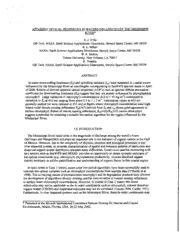
NASA Technical Reports Server (NTRS) 20060046698: Apparent Optical Properties in Waters Influenced by the Mississippi River PDF
Preview NASA Technical Reports Server (NTRS) 20060046698: Apparent Optical Properties in Waters Influenced by the Mississippi River
APPARENT OPTICAL PROPERTIES IN WATERS INFLUENCED BY THE MISSISSIPPI RIVER* E. J. D'Sa GB Tech, NASA, Earth Science Applications Directorate, Stennis Space Center, MS 39529 R. L. Miller NASA, Earth Science Applications Directorate, Stennis Space Center, MS 39529 B. A. McKee Tulane University, New Orleans, LA 7081 1 R. Trzaska GB Tech, NASA, Earth Science Applications Directorate, Stennis Space Center, MS 39529 ABSTRACT In-water downwelling irradiance (Ed) and upwelling radiance (L,) were measured in coastal waters influenced by the Mississippi River at wavelengths corresponding to SeaWiFS spectral bands in April of 2000. Results of derived apparent optical properties (AOP7s)s uch as spectral diffise attenuation coefficient for downwelling irradiance (Kd) suggest that they are mainly influenced by phytoplankton chlorophyll. Large variations in chlorophyll concentrations (0.2 to > 10 mg me3)c orrespond to variations in &at 443 nm ranging from about 0.1 to > 1.5 m-'. Attenuation values at 443 nm generally peaked (or were minimal at 555 nm) at depths where chlorophyll concentrations were high. Above water remote sensing reflectance R,,(443) derived from Ed and L, shows good agreement to surface chlorophyll. Ratios of remote sensing reflectance, RrS(443YRrs(555)v ersus chlorophyll suggests a potential for obtaining a suitable bio-optical algorithm for the region influenced by the Mississippi River. 1.0 INTRODUCTION The Mississippi River ranks sixth in the magnitude of discharge among the world's rivers (Milliman and Meadel 983) and plays an important role in the transport of organic carbon to the Gulf of Mexico. However, due to the complexity of physical, chemical and biological processes in this river impacted system, an accurate characterization of spatial and temporal patterns of particulate and dissolved organic matter distribution presents many difficulties. Ocean color satellite monitoring with new sensors such as SeaWIFS and MODIS provides an opportunity to obtain synoptic estimates of bio-optical constituents (e.g. chlorophyll, phytoplankton productivity, colored dissolved organic matter) necessary to aid the quantification and understanding of organic fluxes in this coastal region. In open ocean or Case I waters, ocean color bio-optical algorithms have been successfully used to estimate bio-optical variables such as chlorophyll concentrations from satellite data (OYReillye t al. 1998). The co-varying nature of phytoplankton chlorophyll and its degradation products have allowed the development of algorithms directly relating satellite derived ratios of remote sensing reflectance to surface water chlorophyll concentrations. However, in coastal or Case 2 waters this direct relationship may not be applicable as the in water constituents such as chlorophyll, coIored dissolved organic matter (CDOM) and suspended sediments may not be correlated (Tassan 1994, Carder 1991). Furthermore, in river impacted systems such as the Mississippi River, these in-water constituents may * Presented at the Seventh International Conference Remote Sensing for Marine and Coastal Environments, Miami, Florida, USA, 20-22 May 2002
